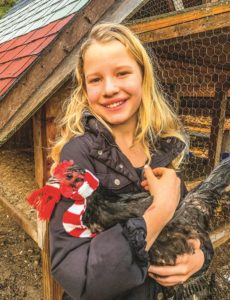We’re bundling up and our furry friends are growing thick coats, but what about our feathery flocks? How do domestic chickens get through the freezing winter months?
I became a backyard chicken farmer in 2015 — a year of icy storms and many feet of snow. My notoriously calm husband, a Cape Cod native, winterized our coop just as he had seen his Eastham neighbors do growing up, by doing nothing at all. No heaters, no extra insulation, no booties to cover the tender skin on their bare feet. “They’ll do just fine,” he promised.
The night the first nor’easter hit, I got out of bed and snuck my sleeping chickens, one by one, into our warm home, where they roosted happily in pairs on the backs of our kitchen chairs. My dear husband was not all that calm about the poop that covered the floor the next morning.
I learned a lot that winter. The chickens made it through just fine — outdoors. And their poop, properly placed, actually played a role in their survival.
Although there is some debate about this, domestic chickens were likely brought to the U.S. sometime in the early 1800s. Until the late 1950s, they were raised on small farms, where they roamed about the yard and at night roosted with the other animals in the barn. The sad chapter of large-scale production of confined poultry didn’t begin until around 1960. Partly in reaction to that, interest in backyard chickens has steadily grown — and, with it, the marketing of all sorts of fancy chicken gear you really don’t need.
A heater or heat lamp inside your coop could quickly become a fire hazard. And chickens that grow accustomed to heated coops can become less hardy and more disease prone. Don’t feel you have to insulate your roosting house as we do our homes. Fresh air is important for poultry health — in fact, you need to maintain some ventilation even during the coldest months.

Some chicken farmers hang lights in their coops when the days get shorter, so their hens will continue to lay. We prefer to allow our ladies to rest during the winter months, which also helps them to preserve their energy to stay healthy and warm.
Most important for your flock’s winter health are a dry area within the coop, a draft-free roosting perch large enough for the entire flock to huddle close together, and a diet somewhat higher in carbs. Cracked corn and sunflower seeds are excellent additions to regular feed.
Chickens also need daily access to water, of course, so the one specialized purchase you might make for your convenience in winter is a hotplate-type water-warmer or a heated bucket to keep water from freezing.
Chickens don’t like being out when winds are icy and fresh snow is falling. They are, in fact, “snow blind” — they can’t see in brilliantly white fresh snow. Throwing some hay onto the ground or shoveling a path in their run may help them get into the mood for a winter walk, but some of our hens simply don’t like to get their tender bare feet cold. They like to stay entirely off the ground on snowy days. Your more delicate birds, especially, will appreciate having ramps and branches to climb on.
What about the role of poop in a flock’s winter survival? One old-fashioned way to help your chickens stay warm in winter is called the “deep litter” method of coop management. You clean your coop once at the beginning of winter and then don’t do it again until the end of March. Instead, let layers of straw and manure accumulate, adding fresh dry straw each week on top of the old. The straw and poop will compost, and in the process give off enough heat to keep your birds cozy till spring.



